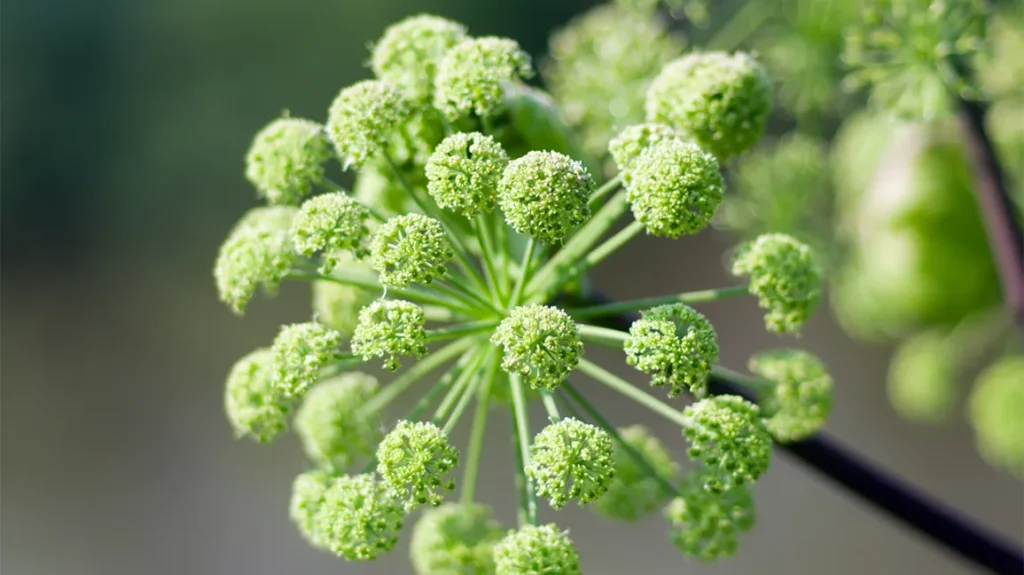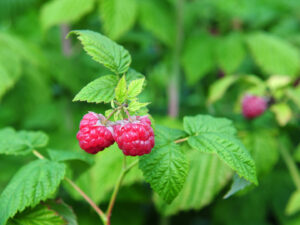Angelica
Root

Angelica Root, derived from the Angelica archangelica plant, is a powerful herb that has been used for centuries in traditional medicine and spiritual practices. The plant is native to temperate and subarctic regions of the Northern Hemisphere, including parts of Europe and Asia. The root is known for its aromatic qualities and is often used to treat various ailments, particularly those related to digestion and respiratory health. It is also a common ingredient in herbal liqueurs and bitters.
1. Size:
- The Angelica plant can grow up to 1.5 to 2.5 meters (5 to 8 feet) tall. The root itself is thick, fleshy, and can grow quite large, extending deep into the soil.
2. Color:
- The root is typically a light brown or beige color on the outside, with a creamy white interior. The plant’s leaves are a deep green, and it produces large, umbrella-shaped clusters of small, yellow-green flowers.
3. Texture:
- Angelica Root has a firm and fibrous texture. When dried, it becomes tough and woody, which makes it suitable for long-term storage. The root is usually sliced or ground into a powder for medicinal use.
4. Fragrance:
- The root has a strong, earthy, and slightly musky aroma, with hints of sweetness. This fragrance is more pronounced when the root is dried and ground.
5. Uses:
- Angelica Root is commonly used to treat digestive issues, including indigestion, bloating, and gas. It is also used as a remedy for respiratory conditions such as bronchitis and coughs.
- The root is sometimes used as a flavoring in liqueurs, bitters, and confectionery. It imparts a distinct, slightly bitter taste that complements sweet and savory dishes.
- Angelica Root oil is used in aromatherapy for its calming and grounding properties. It is believed to help relieve stress and anxiety.
- The root has been used in traditional medicine for centuries to treat a variety of ailments, including menstrual discomfort and joint pain.
6. Habitat:
- Angelica Root thrives in moist, well-drained soils in cool climates. It is often found in meadows, along riverbanks, and in mountainous regions. The plant prefers partial shade but can tolerate full sun in cooler climates.
7. Cultural and Spiritual Significance:
- Angelica Root has been used in various cultures as a protective talisman. It is believed to ward off evil spirits and negative energies. It is also used in purification rituals to cleanse spaces and individuals.
- Historically, Angelica Root was revered for its healing properties and was often used in religious ceremonies to promote health and well-being.
Spiritual Properties
- Protection: Angelica Root is often used in spiritual practices for protection against negative influences. It is believed to create a protective barrier when used in rituals or carried as a charm.
- Healing and Strength: The root is associated with physical and spiritual healing, offering strength and resilience to those who use it. It is often included in healing rituals and spells.
Medicinal Properties
- Digestive Aid: Angelica Root is well-known for its ability to relieve digestive issues. It stimulates appetite, reduces bloating, and alleviates indigestion. The root’s carminative properties make it effective in treating gas and stomach cramps.
- Respiratory Support: The root is also used to treat respiratory conditions. It acts as an expectorant, helping to clear mucus from the lungs and ease symptoms of bronchitis and colds.
- Menstrual Relief: Angelica Root has been traditionally used to ease menstrual discomfort and regulate menstrual cycles. It is believed to support overall reproductive health.
- Anti-inflammatory: The root possesses anti-inflammatory properties, making it useful in treating conditions such as arthritis and joint pain.
Allergic Reactions
Angelica Root is generally considered safe for most people, but it may cause allergic reactions in some individuals.
- Skin Sensitivity: Handling or applying Angelica Root oil can cause skin sensitivity or irritation, especially when exposed to sunlight. This photosensitivity can lead to redness, itching, or a rash.
- Respiratory Irritation: Inhalation of Angelica Root powder or smoke may cause respiratory irritation in sensitive individuals. Symptoms could include coughing, shortness of breath, or a sore throat.
- Photosensitivity: Angelica Root contains compounds that can increase sensitivity to sunlight, potentially leading to sunburn or skin irritation when exposed to UV light. It is advisable to avoid prolonged sun exposure after using Angelica Root products on the skin.
- Blood Thinning: The herb may have blood-thinning effects, which could be problematic for individuals taking anticoagulant medications or those with bleeding disorders. Caution is advised when using Angelica Root in such cases.
- Dizziness: Some individuals may experience dizziness or lightheadedness after consuming Angelica Root, especially in larger doses. This side effect may be mitigated by reducing the dosage.
- Upset Stomach: Although Angelica Root is used to aid digestion, it may cause an upset stomach or nausea in some individuals, particularly if taken in large quantities.

Uva Ursi
Uva Ursi Uva Ursi, also known as bearberry, is a small, evergreen shrub that is prized for its medicinal properties, particularly in treating urinary tract

Raspberry Leaf
Raspberry Leaf Raspberry Leaf is a versatile herb that comes from the red raspberry plant. It has been used for centuries in traditional medicine for

Menthol Crystals
Menthol Crystals Menthol Crystals are derived from peppermint oil and are known for their strong, cooling sensation and refreshing fragrance. These crystals are used in

Palo Santo Chips
Palo Santo Chips Palo Santo, also known as "Holy Wood," is a sacred wood revered for its aromatic properties and spiritual significance. It is commonly

Healing Bath for Emotional Trauma
Healing Bath for Emotional Trauma This bath is designed to aid in emotional healing and the release of negative feelings, making it ideal for times

Jojoba
Jojoba Jojoba (Simmondsia chinensis) is a perennial shrub native to the arid regions of the southwestern United States and northern Mexico. The plant is best